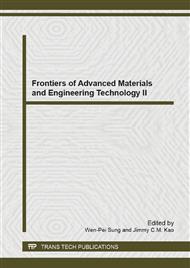p.107
p.111
p.115
p.119
p.123
p.127
p.131
p.136
p.141
Effects of 60Co-Irradiation on Gas Permeation Properties of Polyimide Membranes
Abstract:
Radiation effects on polyimide (PI) membranes were studied with different irradiation doses by 60Co. The PI membrane were synthesized from 2,2-bis (3-amino-4-hydroxyphenyl) hexafluoropropane (Bis-AP-AF) with 3,3',4,4'-Benzophenone tetracarboxylic dianhydride (BTDA). The single gas permeability of He, H2, CO2, O2, N2 and CH4 were measured and compared in order to determine the effect of the the irradiation doses on the gas separation properties. The results showed that the ideal selectivity of He/CH4, H2/CH4, CO2/CH4 and H2/N2 of the irradiation PI membrane can be significantly improved by irradiation of 60Co source. The optimum irradiation doses were 50 kGy. The highest ideal selectivity of He/CH4, H2/CH4, CO2/CH4 and H2/N2 is 3635.86, 2287.57, 282.00 and 205.29, respectively. In other word, the ideal selectivity of He/CH4, H2/CH4, CO2/CH4 and H2/N2 of the irradiation PI membrane with 50 kGy irradiation doses is 2.27, 2.11, 1.89 and 1.08 times higher than that of the PI membranes without irradiation.
Info:
Periodical:
Pages:
123-126
Citation:
Online since:
April 2014
Authors:
Keywords:
Price:
Сopyright:
© 2014 Trans Tech Publications Ltd. All Rights Reserved
Share:
Citation:



